Repair of the Oasis geyser: overview of typical breakdowns and recommendations for their elimination
Malfunctions happen in any equipment, regardless of the manufacturer.Be it a famous German brand or its Chinese equivalent. The difference is that in the second one they occur more often.
The breakdown of such an irreplaceable device as a geyser creates a lot of inconvenience. If the malfunction is not related to a gas leak, in most cases, you can repair the Oasis geyser yourself. We will talk in detail about what kind of breakdowns are most often diagnosed in speakers of this popular brand among users, as well as how to fix them in this publication.
The content of the article:
Types of brand geysers
Based on the type of water heating, the columns are divided into two types: flow and storage.
The former heat a continuous stream of water passing through an internal coil under the pressure of the plumbing system. The work of the latter involves pre-filling the tank by analogy with electric boilers.
Heating the water takes a certain time depending on the tank capacity. This type of water heater is extremely rare and is not in demand among domestic buyers.
Flow-through geysers have become most widespread, primarily due to the rapid heating of water.This article will discuss exactly this type of column.
Depending on the method of removing combustion products, Oasis geysers are: chimney And turbocharged (chimneyless).
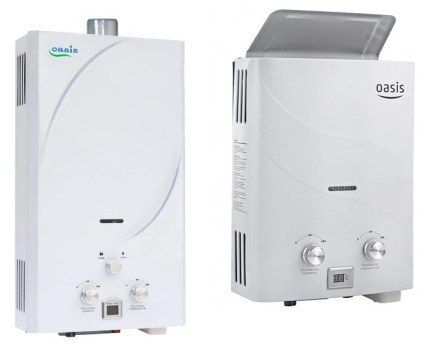
A distinctive feature of the latter is its own ventilation system, designed in the form coaxial double-circuit chimney. Consists of two pipes nested one inside the other. Combustion products are removed through the internal pipes, and air from the street enters into the gap between the pipes.
Forced ventilation turbocharged speakers are powered by an internal fan. This requires increased power supply compared to conventional chimney devices. Therefore many chimneyless models are powered from the network.
Internal structure of the Oasis speaker
Before you start troubleshooting the Oasis geyser and choosing a method to eliminate them, you must clearly understand what type of device it is, know the device, and the principle of its operation.
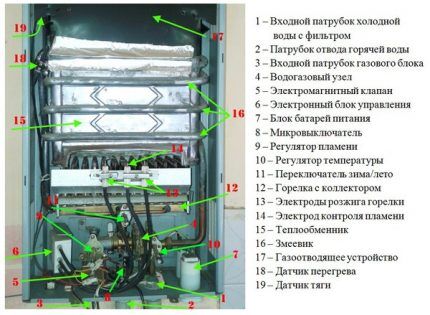
The diagram above shows the design of a typical gas water heater, which is also typical for Oasis columns. Let's look further at how the most common type works. chimney brand flow model with automatic ignition.
When you open the tap, water flows through the inlet pipe into the water-gas a unit that includes ignition and gas supply. As soon as it ignites, a signal is sent from the flame sensor to the electronic unit to stop sparking.
Next, the water passes through a coil rigidly fixed to a heat exchanger, which is heated by burning gas. The coil transfers heat to the flowing water coming out.
When the tap closes, water-gas the unit turns off the gas supply. The combustion stops and the column goes into standby mode for the water tap to open.
An important condition for the normal and safe operation of the column is the removal of combustion products through the ventilation chimney. If the hood is missing or insufficient, the draft sensor is triggered and the column is turned off.
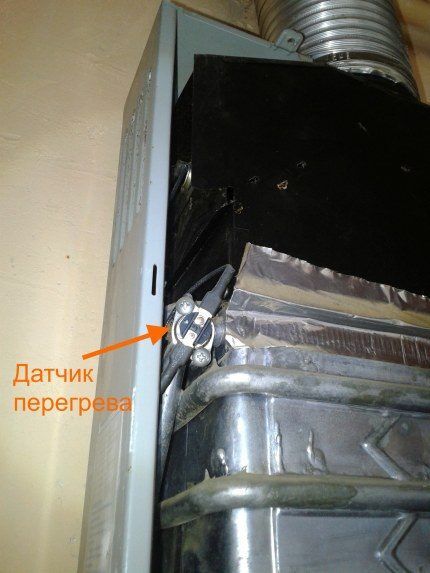
Maintaining the required temperature regime is an equally important condition for fire safety and long service life of the column. Overheating negatively affects the condition of all elements, primarily the heat exchanger, which leads to their premature failure.
Frequent malfunctions and their elimination
Before you start troubleshooting the Oasis brand column and choosing a solution, you need to make sure that there is a normal water pressure in the system and drafts in the chimney. It is better to check the draft with a candle or match; the flame should deviate well until it extinguishes.
Let's consider the most common malfunctions that appear during the operation of Oasis speakers, possible causes of their occurrence, and methods of elimination.
Problem #1 - the flame in the burner does not ignite
If the Oasis gas water heater does not light up, there may be several main reasons. Let's talk about the main ones.
Insufficient power supply to the speaker
Insufficient power supply or no power supply.The most likely and simplest reason for this malfunction lies in dead batteries. If, when you open the tap, you hear a discharge crackling sound, there is a spark, the pressure is normal, but the gas does not ignite, then the reason is most likely in the batteries.
Over time they lose their capacity. Their power drops, they cannot supply the required current to the load. It is only enough to start a high-voltage generator, and there is not enough power to open the solenoid valve.
Deterioration of contacts in the battery compartment due to corrosion and contamination can also cause ignition problems. Corrosion can be caused by leaking batteries or moisture entering the contacts from the outside.
Remedy: replace batteries for new ones. Alkaline elements should be installed. First you need to check the condition of the contacts. If necessary, wipe them with alcohol, or clean them with sandpaper, a knife or a file. If corrosion damage occurs as a result of moisture ingress, the source should be identified and the leak repaired.
For chimneyless columns, lack of ignition may be due to a malfunction network power supply. Only in this case there will be no spark discharge.
Weak pressure at the water heater outlet
Deterioration of water flow through the column is a common occurrence.
If the water pressure in the system is normal, but the outlet of the column is weak, then there may be several options:
- the filter at the inlet of the water block is clogged;
- the throughput of the heat exchanger coil is impaired due to scale;
- the mesh divider (aerator) on the hot water tap is clogged;
- a piece of scale got into the flexible hose supplying hot water to the tap.
Remedy: remove, clean, rinse mesh filters under running water.Replace flexible hose. Clean the heat exchanger.

Water unit malfunction
Under the pressure of the incoming water flow, the membrane pushes the rod, which opens the mechanical gas valve and presses the button microswitchactivating the ignition.
This mechanism may fail for the following reasons:
- the membrane is worn out, over time it loses its properties, elasticity, and breaks;
- the rod is stuck.
Remedy: disassemble the water unit. If the threaded connections are stuck, treat them with anti-corrosion agent WD-40 or brake fluid and leave for half an hour. Then replace the membrane, lubricate the rod, spring and seal. It is better to install a new silicone membrane; it will last longer.
Malfunction microswitch or solenoid valve
You can check the serviceability of the microswitch and solenoid valve multimeter. To do this, it must be switched to resistance measurement mode with a minimum limit. Connect the probes to the terminals mmicroswitch and alternately press and release the button.
If the readings of the device vary from one ohm to infinity, then the switch is most likely working. If the readings do not change - microswitch faulty
To check the solenoid valve, you need to measure the resistance of the solenoid windings at the connector terminals. It should be about 400 ohms between the black and yellow wires, and the yellow and red. Between the red and black wires - about 7 ohms. If the measurement results are significantly different, the solenoid valve is faulty.
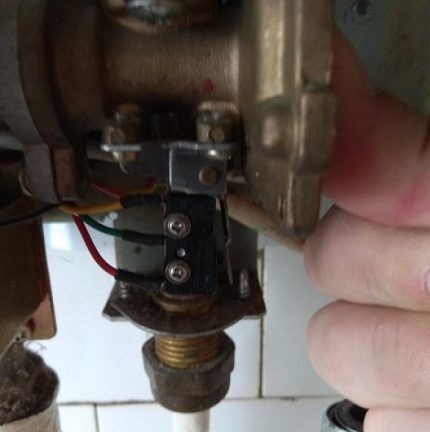
Remedy: these elements cannot be repaired and must be replaced.
Problem #2 - The flame comes on and goes out
This happens when the electronic unit does not receive the ignition signal, stops ignition and shuts off the gas. The cause may be a malfunction flame sensor or carbon deposits on the sensor.
Remedy: lightly clean the sensor with fine sandpaper (zero sandpaper). In this case, you should not be too zealous so as not to damage the metal coating. If this procedure does not produce results, you must replacing the flame sensor.
Problem #3 - the device goes out after a few minutes
This malfunction is often associated with poor traction or overheating.
Remedy: clean the chimney, reduce the water temperature by adjusting the flame and pressure, do not dilute the hot water with the mixer.
Problem #4 - column leakage
To determine the exact location of the leak, you need to remove the front panel and carefully inspect all the components of the column. The most common leak occurs in the water block or heat exchanger.
The stem seal is leaking
The water-gas unit has one design feature that is not visible in its normal position. There is a hole in the back wall through which the rod controls the microswitch lever. Leaks often occur through it when the oil seal wears out.
This feature of the device water block The Oasis geyser can only be seen from the reverse side when the unit is removed.

Remedy: remove the batteries, remove the battery installation unit. Unscrew the nuts on the inlet and outlet pipes of the water block. Disconnect the water supply pipe (hose) and radiator tube. Disassemble the water unit, replace the oil seal or the entire rod.
Radiator leak and its elimination
Heat exchangers made of copper and copper-containing alloys The reason is that manufacturers often use alloys in which the percentage of copper is lower and lower.
During operation, as a result of corrosion and mechanical damage, small holes begin to appear, violating the tightness of the radiator. These are the so-called “fistulas”. In these places, the heat exchanger begins to let water through.
By the way, even a high-quality copper heat exchanger is not protected from rapid destruction - corrosion occurs under the influence of stray currents that arise in the water supply if the column is not grounded correctly or if other operating rules gas-using equipment.
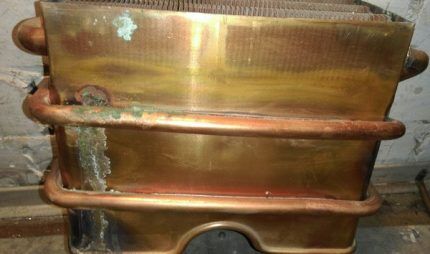
Elimination: you can replace the heat exchanger with a new one, but this will cost a third of the price of the column. Often this is not justified; it is much easier to solder it without disassembling the entire column and removing the radiator.
Before you start soldering, you need to drain all the water from the radiator, otherwise heating the pipeline will be problematic. To do this, you need to turn off the water supply to the column, disconnect the incoming pipe from the pipe, place a container under it, and open the hot water tap.
When the water has drained, it is necessary to blow through to remove residues. You can use a vacuum cleaner or compressor. If such devices are not at hand, you can blow through with your mouth. To do this, you need to select a rubber hose of suitable diameter and fit it tightly onto the coil, strengthen the connection by crimping.
Soldering can be done in two ways: with a gas torch or a soldering iron.
Soldering with a gas torch
For soldering you will need burner with gas cartridge, sponge, flux paste containing tin and copper, solder.
Start by heating the leaking tube to evaporate any remaining water. Clean the soldering area with a sponge. Apply flux paste. Heat again until the flux color changes from gray to silver.
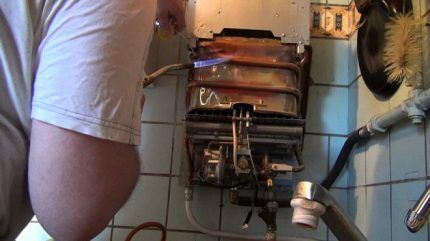
To prevent flux residues from leading to corrosion, it is necessary to remove them with a damp cloth.
We have provided detailed instructions on soldering copper tubes with a gas torch. in this material.
Soldering the column with a soldering iron
Prepare a powerful soldering iron of 100 W or more, POS-50, POS-61 or other solder with a melting point of at least 200 degrees. Flux: rosin or solder fat, you can also use aspirin tablets. Using a hair dryer makes warming up much easier.
The soldering area must be cleaned with a zero polish until all traces of corrosion are removed from the metal surface. Then skimmedClean it with alcohol or solvent.
Heat the soldering area well with a soldering iron. Additional heating with a hair dryer gives excellent results. Tin soldering iron tip with a piece of solder.Apply a small amount of flux to the soldering area and immediately tin the metal surface with a soldering iron. Try to maintain the fluidity of the solder by adding flux from time to time. Bring the solder thickness to 1-3 mm.
With good heating, a thin layer of solder is enough to reliably eliminate a leak and prevent destruction of the pipeline at the soldering site.
Problem #5 - reduced pressure and low water heating
Signs scale formation in the heat exchanger are a decrease in the water flow at the outlet of the column and its low heat. In this case, the column may not ignite well, and the radiator overheats due to poor heat exchange with water. This triggers the thermal protection sensor and turns off the column.
Radiator fins clogged also leads to overheating. When they become clogged with debris and scale, it becomes difficult for combustion products to exit into the chimney, which can lead to burnout of the heat exchanger skirt.
Water hardness is the main reason for the deterioration of pipeline capacity. The presence of calcium, magnesium salts and other impurities promotes scale formation and reduces heat transfer. Heating significantly enhances this process.
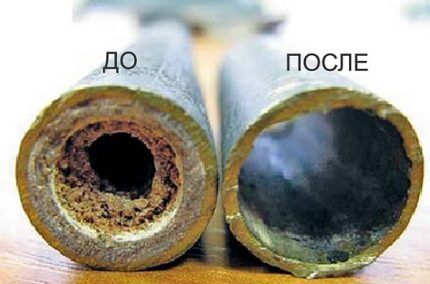
You cannot use a column with heat exchanger tubes clogged with scale. This will lead to local overheating, cracks in the coil and the need to replace it.
Remedy: wash the heat exchanger with a special solution. There is a wide selection of reagents for professional use.They do the best job of removing scale without damaging the pipeline.
Most chemicals contain solutions of various acids. Their concentration and composition are selected in such a way as to effectively dissolve salt deposits, but act as gently as possible on the inner surface of the pipeline. The selection of a suitable reagent should take into account the heat exchanger material.
For example, reagents intended for copper radiators cannot be used for pipelines made of galvanized and stainless steel and vice versa.
The highest quality washing is done using special equipment (boosters). The effect is achieved through repeated circulation of the reagent, its heating, reverse, and the use of special compounds. The cost of such equipment, as well as services, is quite high. Purchasing boosters is more justified for professional use.
Good results can be achieved in less expensive ways using available devices and reagents.
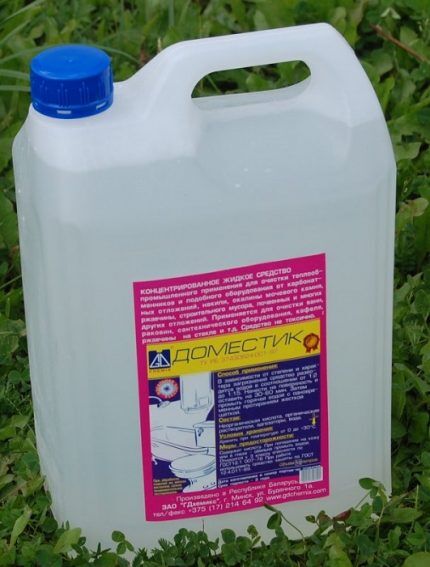
To remove scale, 10–20% solutions are usually used. For 1 liter of water take 100 g - 200 g antiscale or citric acid or 9% vinegar. The greatest effect is achieved when the solution is heated to 80 - 100 degrees.
Washing can be done in two ways:
- without dismantling the radiator;
- with removal of the heat exchanger.
To flush the radiator without removing, there are a number of actions to be performed.First, turn off the water by placing a container to drain. Disconnect the outlet pipe and open the tap. Next, unscrew the nut connecting the coil to the water block. Connect a funnel from a cut plastic bottle with a flexible hose to the inlet of the coil.
Then secure the funnel above the heat exchanger. Pour the working solution into the funnel in small portions until foam appears at the other end of the coil. The procedure must be carried out for 4-6 hours until the chemical reaction stops, guided by the foam released, or using acidity indicators.
WITH dismantling heat exchanger washing is carried out as follows: first disassemble the column, remove the radiator and burner. Then the plate is cleaned of soot and soot. After this, place the radiator in a large metal container with water, pour the reagent inside the pipeline and heat the container. At the end, the heat exchanger should be rinsed with cold water and a 10% soda solution.
How to extend the life of the column?
The longevity of a speaker depends on many factors. The main part of them is laid at the manufacturer, the rest are determined by operating conditions.
By following some rules and recommendations, you can significantly reduce the number of breakdowns and extend the life of the column.
Features of using batteries
Of all the parts, batteries require the most frequent replacement. For geysers, you should choose only alkaline batteries made using Alkalin power technology, size “D” and the first letter “L” in the designation is LR20. Their capacity and service life are five times greater than those of salt ones: from 1 to 1.5 years.
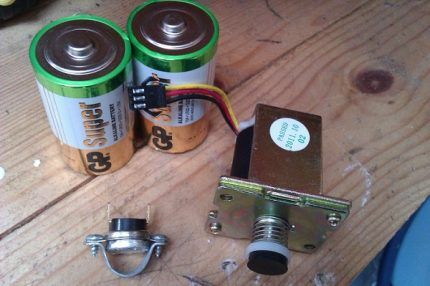
High-quality batteries cost from $1.2. There is a radical way to reduce the cost of replacing batteries - converting the speaker to power from the mains.
To do this, you can buy a special 3 V power supply, or use a 5 V mobile phone charger with an additional stabilizer. The main requirement is that its power is sufficient for ignition, which occurs at a supply voltage of 3 V and a current of 350 mA.
In case of a power outage, you can always keep batteries in reserve, fortunately, alkaline shelf life 5 years or more.
Column heat exchanger quality
When choosing a column, special attention should be paid to the quality of the heat exchanger. The type of metal and its quality have a great influence on the lifespan of the radiator. They are made of galvanized steel, stainless steel, copper.
The most durable of stainless steel, but inferior in thermal conductivity to copper. Accordingly, they are less economical and have lower efficiency. Copper is the most efficient in heat transfer, but also the most expensive.

The high cost of copper leads to the fact that manufacturers save as much as possible on the thickness of the heat exchanger wall, bringing it down to 0.5 mm, which significantly reduces the service life. For the same reason, other metals are added to copper. The alloy obtained in this way may have unpredictable properties. As a result, such a heat exchanger cannot even be soldered.
System water quality
If the water in the system is subjected to frequent chlorination, this will negatively affect the condition of the copper heat exchanger. In combination with the thinned walls of the pipeline, this can quickly lead to corrosion and the appearance of fistulas.
Increased water hardness in combination with heating causes no less problems. Scale deposits require periodic washing.
Water quality can be improved by using aqua filters and magnetic softeners. Detailed information and selection rules filter for water purification from the water supply is given in the following publication.
Overheating of the geyser
The most important factor leading to malfunctions and reduced service life of the column is its overheating. It is important not to raise the temperature to 65 degrees or higher.
To reduce the risk of the water becoming too hot, do not use the faucet to cool the water. Only change the temperature using the flame and water flow control knobs intended for this purpose.
Conclusions and useful video on the topic
The following story illustrates the repair of a gas water heater and fistulas:
How to clean a gas water heater using chemicals and solve the problem of low water pressure:
Compliance with these simple rules will contribute to the long-term operation of the gas water heater without breakdowns or repairs. It is important to remember that gas leaks or poor ventilation can lead to tragic consequences. At the first sign of a gas smell, you need to call the emergency service “04”.
Would you like to tell us how you yourself repaired an Oasis brand gas water heater? Share your experience with other visitors to our site, tell us about the difficulties you encountered in the process of disassembling the column, add a photo - the comment form is located below.




Oasis or-20w, the gas engineer fixed the gas supply solenoid valve, in the end he replaced the batteries himself and the boiler started working! A very useful article on this site, thanks for the practical advice and detailed description of the problems.
Thank you very much, it turned out that I also had a problem with the batteries. There is a spark, but no ignition. Who would have thought…